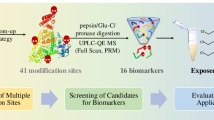Abstract
Diisocyanates are potent inducers of airways disease. Methylenediphenyl diisocyanate (MDI) is a widely used diisocyanate in the chemical industry. The aim of this study was to identify major and also immunologically relevant protein conjugates of MDI in plasma. Plasma was obtained from an MDI-exposed worker. The plasma was dialysed and then fractionated using ion exchange chromatography (IEC) and gel filtration. These fractions and also aliquots of unfractioned plasma were hydrolysed, derivatised and analysed for isocyanate adduct content using gas chromatography–mass spectrometry. In addition, immunologically relevant proteins were identified through specific IgG immunoblotting using pooled sera from two exposed workers. It was shown by dialysis that 96% of the hydrolysed MDI derivatives were protein bound and that 95% of the MDI adducts co-eluted with serum albumin in plasma using IEC. All MDI–protein adducts co-eluted with serum albumin using gel filtration. IgG immunoblotting showed a major 66 kDa protein and also some intermolecular reactions in serum albumin. This study shows serum albumin to be the major protein in plasma that forms adducts in vivo with MDI. Thus, a quick and simple quantitative method for biological monitoring may be developed for MDI exposure. The results also showed that MDI-specific IgG antibodies preferentially bind to the serum albumin in in-vitro-synthesised MDI–plasma protein conjugates.



Similar content being viewed by others
References
Baur X, Marek W, Ammon J, Czuppon AB, Marczynski B, Raulf-Heimsoth M, Roemmelt H, Fruhmann G (1994) Respiratory and other hazards of isocyanates. Int Arch Occup Environ Health. 66:141–152
Dalene M, Skarping G, Lind P (1997) Workers exposed to thermal degradation products of TDI- and MDI-based polyurethane: biomonitoring of 2,4-TDA, 2,6-TDA, and 4,4′-MDA in hydrolyzed urine and plasma. Am Ind Hyg Assoc J 58:587–591
Ehrenberg L, Hiesche KD, Osterman-Golkar S, Wenneberg I (1974) Evaluation of genetic risks of alkylating agents: tissue doses in the mouse from air contaminated with ethylene oxide. Mutat Res 24:83–103
Jin RZ, Karol MH (1988) Intra- and intermolecular reactions of 4,4′-diisocyanatodiphenylmethane with human serum albumin. Chem Res Toxicol 1:281–287
Johannesson G, Rosqvist S, Lindh CH, Welinder H, Jönsson BAG (2001) Serum albumins are the major site for in vivo formation of hapten-carrier protein adducts in plasma from humans and guinea-pigs exposed to type-1 allergy inducing hexahydrophthalic anhydride. Clin Exp Allergy 31:1021–1030
Johansson B (1972) Agarose gel electrophoresis. Scand J Clin Lab Invest 29 [Suppl 124]:7–20
Lind P, Dalene M, Lindstrom V, Grubb A, Skarping G (1997) Albumin adducts in plasma from workers exposed to toluene diisocyanate. Analyst 122:151–154
Schütze D, Sepai O, Lewalter J, Miksche L, Henschler D, Sabbioni G (1995) Biomonitoring of workers exposed to 4,4′-methylenedianiline or 4,4′-methylenediphenyl diisocyanate. Carcinogenesis 16:573–582
Sennbro CJ, Lindh CH, Tinnerberg H, Gustavsson C, Littorin M, Welinder H, Jonsson BA (2003) Development, validation and characterization of an analytical method for the quantification of hydrolysable urinary metabolites and plasma protein adducts of 2,4- and 2,6-toluene diisocyanate, 1,5-naphthalene diisocyanate and 4,4′-methylenediphenyl diisocyanate. Biomarkers 8:204–217
Sepai O, Henschler D, Sabbioni G (1995) Albumin adducts, hemoglobin adducts and urinary metabolites in workers exposed to 4,4′-methylenediphenyl diisocyanate. Carcinogenesis 16:2583–2587
Shevchenko A, Wilm M, Vorm O, Mann M (1996) Mass spectrometric sequencing of proteins silver-stained polyacrylamide gels. Anal Chem 68:850–858
Spanne M, Tinnerberg H, Dalene M, Skarping G (1997) Determination of complex mixtures of airborne isocyanates and amines. Part 1. Liquid chromatography with ultraviolet detection of monomeric and polymeric isocyanates as their dibutylamine derivatives. Analyst 121:1095–1099
Wisnewski AV, Srivastava R, Herick C, Xu L, Lemus R, Cain H, Magoski NM, Karol MH, Bottomly K, Redlich CA (2000) Identification of human lung and skin proteins conjugated with hexamethylene diisocyanate in vitro and in vivo. Am J Respir Crit Care Med 162:2330–2336
Acknowledgements
This work was supported by grants from the Swedish Council for Work Life Research, the AFA Foundation, the Swedish Research Council and the Medical Faculty at Lund University. The experiments complied with the current laws in Sweden.
Author information
Authors and Affiliations
Corresponding author
Rights and permissions
About this article
Cite this article
Johannesson, G., Sennbro, C.J., Willix, P. et al. Identification and characterisation of adducts between serum albumin and 4,4’-methylenediphenyl diisocyanate (MDI) in human plasma. Arch Toxicol 78, 378–383 (2004). https://doi.org/10.1007/s00204-004-0555-2
Received:
Accepted:
Published:
Issue Date:
DOI: https://doi.org/10.1007/s00204-004-0555-2




